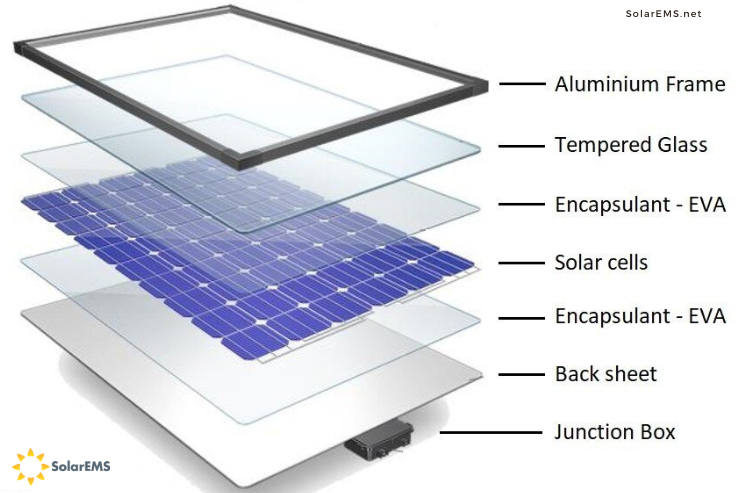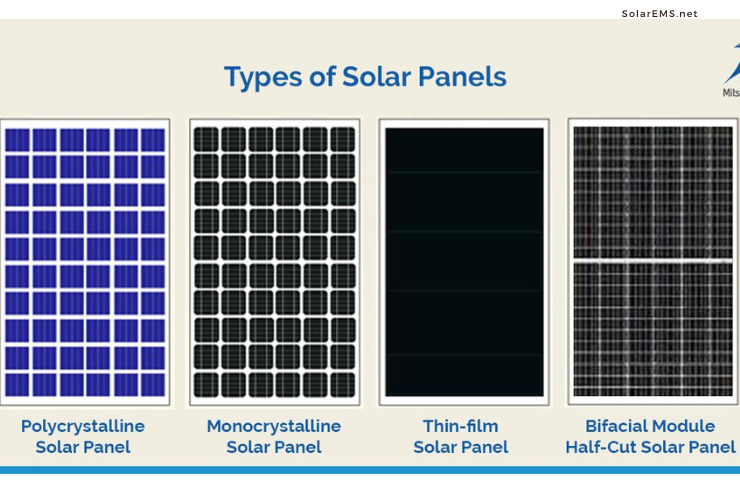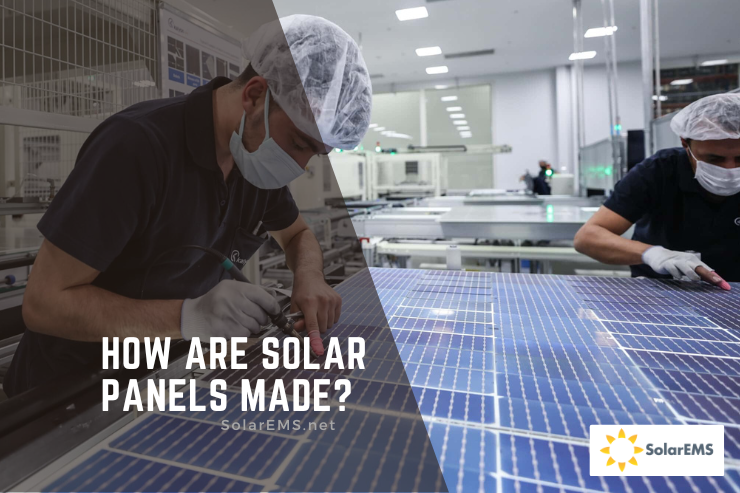According to the Solar Energy Industries Association, the average annual growth rate of solar in the last decade in the US is 33%. Not only the US, but the whole world is also shifting towards Green energy technology to create a sustainable future. If you are looking for alternative energy sources, then using solar energy can be a great idea for your house or for business purposes. However, you should keep in mind that Solar panel installation is a complex process so make sure to hire a proficient engineer. In this article, we are going to learn about how are solar panels made, Different types of solar panels, Solar panel advantages and disadvantages, etc.
Definition of solar panels
A solar panel is a device used to collect energy from the sun in the form of sunlight and convert it into electricity that can be used to power homes, businesses, or industrial facilities. Solar panels are constructed using photovoltaic cells made up of layers of silicon, phosphorus, and boron that absorb photons from the sun which helps to generate an electric current through a process known as the photovoltaic effect. Solar panels are used to generate electricity from a small to large scale with a number of solar panels arranged into vast solar arrays to provide electricity.
Importance of solar panels
- Using solar energy is not just beneficial for you as it saves you on electricity bills in the long run. It also helps to create a sustainable environment and reduce the impact of climate change.
- Solar panels generate electricity using renewable energy from the sun. It helps to reduce your dependence on fossil fuels and decrease greenhouse gas emissions.
- Solar panels can provide homes, businesses, and communities with greater energy independence and security by producing electricity on-site.
- Solar panels can increase property values for homeowners and businesses, making them a good investment.
- Solar panel installation has been growing rapidly in recent years. Hence, it can also create job opportunities in the solar industry.
- Solar panels can be installed on a wide range of surfaces such as rooftops, parking lots, and fields. Hence, it is an adaptable solution for generating renewable energy.
- Apart from electricity generation, solar panels can also be used for heating water and powering other devices such as lights and electronics.
- Solar panel installation can be important for those who lack access to reliable electricity or are located in remote areas.
A brief overview of how solar panels are made
- Solar panels are made of multiple layers of materials and the most important layer is photovoltaic (PV) cells, which convert sunlight into electricity.
- The production process of solar panels begins with the manufacture of silicon wafers which is the base material for the cells. Silicon is the second most abundant element on earth.
- The silicon garnered is in the shape of rocks which are melted and purified to form ingots and then cut into fine wafers then they are cleaned.
- The wafers are then coated with a layer of phosphorus and a layer of boron to create a p-n junction to generate an electrical field within the cell.
- After that, metal contacts are added to the top and bottom of the cell to allow for the flow of electricity.
- Then the cells are assembled into panels and connected in series to produce the desired voltage and current output. The panels are then sealed with a layer of glass and a protective backing material to ensure durability and longevity.
Materials Used in Making Solar Panels

A. Silicon
Silicon is the most commonly used material for solar cells as it is a semiconductor that can receive sunlight and convert it into electricity.
B. Glass
Glass is used as the front cover of the solar panel to protect the cells from damage and weathering.
C. Metal
Metal is used for the frame of the solar panel to provide structural support and allow for easy installation.
D. Back sheet material
The back sheet material is a protective layer that covers the back of the solar panel and provides insulation from moisture and other environmental factors.
E. Junction box
A junction box is a component on the back of the solar panel where wires from the cells are connected to each other and to external wires to allow the electricity to be harnessed.
F. Encapsulant
Encapsulant is a layer of plastic that is placed over the solar cells and helps to protect them from moisture and other damage.
Solar Panel Manufacturing Process
A. Cutting and Shaping of Silicon Wafers
The first step in the solar panel manufacturing process is to cut and shape silicon wafers into the desired size and thickness. Silicon wafers are typically around 0.3mm thick and 125 mm in diameter. They are cut into small pieces using a diamond saw and then shaped into the appropriate size and shape using a grinding machine.
B. Etching the Silicon Wafers
Once the silicon wafers are cut and shaped, they are cleaned and etched to remove impurities and create a rough surface. This rough surface helps to absorb more sunlight and improves the efficiency of the solar cell.
C. Doping of Silicon Wafers
The next step is to dope the silicon wafers with boron and phosphorus to create the necessary electrical properties for solar cells. Boron is added to one side of the wafer to create a positive charge, while phosphorus is added to the other side to create a negative charge.
D. Screen Printing of Contacts
After doping, the silicon wafers are screen-printed with a metal paste to create the electrical contacts needed for the solar cell. This is typically done using a screen-printing machine that presses the metal paste onto the surface of the wafer.
E. Soldering of Solar Cells
Once the contacts are in place, the solar cells are assembled by soldering them together in series to create a solar module. The cells are connected by soldering a wire from the negative contact of one cell to the positive contact of the next cell.
F. Encapsulation and Testing
Finally, the solar cells are encapsulated in a protective layer of ethylene vinyl acetate (EVA) and tempered glass. The encapsulated cells are then tested to ensure they are functioning properly and meet the necessary efficiency and quality standards.
Types of Solar Panels

A. Monocrystalline Solar Panels
These are made from a single silicon crystal and are known for their high efficiency and durability. They have a black or dark blue appearance and are the most expensive type of solar panel.
B. Polycrystalline Solar Panels
These are made from multiple silicon crystals and have a speckled blue appearance. They are less expensive than monocrystalline panels but also have slightly lower efficiency.
C. Thin-Film Solar Panels
These are made from a thin layer of photovoltaic material deposited on a substrate. They are flexible and lightweight and can be used in a variety of applications. However, they are less efficient than crystalline solar panels.
D. Concentrated Solar Panels
These use lenses or mirrors to concentrate sunlight onto a small area of photovoltaic material, increasing its efficiency. They are used in large-scale solar power plants but are less commonly used for residential or commercial applications.
Advantages and Disadvantages of Solar Panels
Advantages
- Cost savings: One of the primary advantages of solar panels is that they can help reduce your electricity bill and save you money in the long run. Although the initial investment can be high, the cost of solar panels has been decreasing over the years, and the return on investment can be significant. Solar panels also have a long lifespan, usually around 25 years, which means that you can continue to save money on electricity for many years.
- Reduced carbon footprint: Solar panels are a clean and renewable source of energy, which means that they do not produce any greenhouse gas emissions. This is beneficial for the environment and can help reduce your carbon footprint. Using solar panels can also help reduce your reliance on fossil fuels, which are finite resources and can be harmful to the environment.
- Energy independence: Another advantage of solar panels is that they can provide you with energy independence. With solar panels, you can generate your own electricity and reduce your reliance on the electricity grid. This is especially useful in areas where power outages are common, or where electricity prices are high.
- Low maintenance: Solar panels are relatively low maintenance compared to other sources of energy. Once installed, solar panels require very little maintenance, and you can expect them to last for many years with minimal upkeep.
Disadvantages:
- High initial cost: One of the main disadvantages of solar panels is the high initial cost. Although the cost of solar panels has been decreasing over the years, the upfront cost can still be prohibitive for some homeowners. However, it is important to note that the long-term cost savings and return on investment can make solar panels a worthwhile investment.
- Dependence on weather conditions: Another disadvantage of solar panels is their dependence on weather conditions. Solar panels require sunlight to generate electricity, which means that they are less effective in areas with low sunlight or during cloudy weather. This can impact the amount of energy you are able to generate and can affect your electricity bill.
- Space requirements: Solar panels require a significant amount of space to install, which can be a disadvantage for homeowners with limited roof space or outdoor areas. However, there are now solar panel options available that are more compact and can be installed in smaller spaces, such as solar shingles or tiles.
Final Words
I have been using solar panels for the last 1 decade and I must say it is an incredible invention that can help us reduce our dependence on fossil fuels and move toward a more sustainable future. By generating electricity from the sun, solar panels can provide clean and renewable energy for our homes, businesses, and communities. If you’re considering solar panel installation, I will suggest you do proper research and find a reputable installer who can help you choose the right system for your needs. However, installing solar panels can be expensive but it will save you money in the long run. In short, it is a long-term investment.
Frequently Asked Questions (FAQs)
How long do solar panels last?
Solar panels can last between 25-30 years on average. Moreover, in the last 2 decades, the longevity of solar panels has increased significantly.
How efficient are solar panels?
The average solar panel efficiency can be around 15%. However, it varies and can reach up to 23%.
Can solar panels work at night?
Solar panels cannot produce energy at night because the PV cells present in solar panels can generate electricity only when it has access to sunlight.
How much do solar panels cost?
The cost of solar panels can range from $3,500 to $35,000 and the average cost is $16,000. However, it can vary depending on the size and type of system you are opting for.
Can solar panels work in the winter?
Solar panels can work in the winter as they need the sun’s energy to work and do not need heat.
How do solar panels store energy?
Batteries help to store the excess energy generated by the solar panels during sunlight hours which can be used during cloudy or rainy days.
Do solar panels require maintenance?
Generally, it requires minimal solar panels maintenance such as it should be cleaned and inspected from time to time to make sure there is no debris or dust over the panels.
Are there any government incentives for installing solar panels?
There are solar panel tax incentives for installing solar panels such as federal tax credits and state tax credits. It allows you to lower your tax bill.

